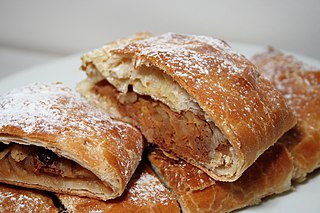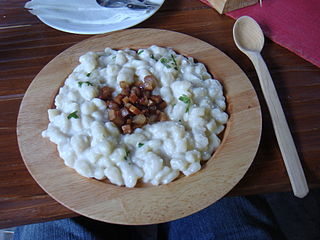
Hungarian or Magyar cuisine is the cuisine characteristic of the nation of Hungary, and its primary ethnic group, the Magyars. Hungarian cuisine has been described as being the spiciest cuisine in Europe. This can largely be attributed to the use of their piquant native spice, Hungarian paprika, in many of their dishes. A mild version of the spice, Hungarian sweet paprika, is commonly used as an alternative. Traditional Hungarian dishes are primarily based on meats, seasonal vegetables, fruits, bread, and dairy products.
Knödel or Klöße are boiled dumplings commonly found in Central European and East European cuisine. Countries in which their variant of Knödel is popular include Austria, Bosnia, Croatia, Czechia, Germany, Hungary, Poland, Romania, Serbia, Slovakia and Slovenia. They are also found in Scandinavian, Romanian, northeastern Italian cuisine, Ukrainian, Belarusian and French (Alsatian) cuisines. Usually made from flour, bread or potatoes, they are often served as a side dish, but can also be a dessert such as plum dumplings, or even meat balls in soup. Many varieties and variations exist.

Polish cuisine is a style of food preparation originating in and widely popular in Poland. Due to Poland's history, Polish cuisine has evolved over the centuries to be very eclectic, and shares many similarities with other national cuisines. Polish cooking in other cultures is often referred to as à la polonaise.

Austrian cuisine is a style of cuisine native to Austria and composed of influences from Central Europe and throughout the former Austro-Hungarian Empire. Austrian cuisine is most often associated with Viennese cuisine, but there are significant regional variations.

Apple strudel is a traditional Viennese strudel, a popular pastry in Austria, Bavaria, the Czech Republic, Northern Italy, Slovenia, Croatia, and other countries in Europe that once belonged to the Austro-Hungarian Empire (1867–1918).

Slovak cuisine varies slightly from region to region across Slovakia. It was influenced by the traditional cuisine of its neighbours and it influenced them as well. The origins of traditional Slovak cuisine can be traced to times when the majority of the population lived self-sufficiently in villages, with very limited food imports and exports and with no modern means of food preservation or processing.

Czech cuisine has both influenced and been influenced by the cuisines of surrounding countries and nations. Many of the cakes and pastries that are popular in Central Europe originated within the Czech lands. Contemporary Czech cuisine is more meat-based than in previous periods; the current abundance of farmable meat has enriched its presence in regional cuisine. Traditionally, meat has been reserved for once-weekly consumption, typically on weekends.

Kue is an Indonesian bite-sized snack or dessert food. Kue is a fairly broad term in Indonesian to describe a wide variety of snacks including cakes, cookies, fritters, pies, scones, and patisserie. Kue are made from a variety of ingredients in various forms; some are steamed, fried or baked. They are popular snacks in Indonesia, which has the largest variety of kue. Because of the countries' historical colonial ties, Koeé (kue) is also popular in the Netherlands.

Monkey bread is a soft, sweet, sticky pastry served in the United States for breakfast or as a treat. It consists of pieces of soft baked dough sprinkled with cinnamon. Often a midmorning/breakfast food. It is often served at fairs and festivals.

The poppy seed roll is a pastry consisting of a roll of sweet yeast bread with a dense, rich, bittersweet filling of poppy seed. An alternative filling is a paste of minced walnuts, or minced chestnuts.

Swabian cuisine is native to Swabia, a region in southwestern Germany comprising great parts of Württemberg and the Bavarian part of Swabia. Swabian cuisine has a reputation for being rustic, but rich and hearty. Fresh egg pastas, soups, and sausages are among Swabia's best-known types of dishes, and Swabian cuisine tends to require broths or sauces; dishes are rarely "dry".

Dumpling is a broad class of dishes that consist of pieces of cooked dough, often wrapped around a filling. The dough can be based on bread, wheat or other flours, or potatoes, and it may be filled with meat, fish, tofu, cheese, vegetables, or a combination. Dumplings may be prepared using a variety of cooking methods and are found in many world cuisines.











